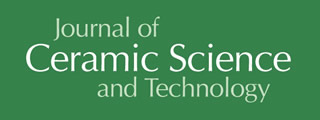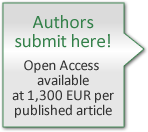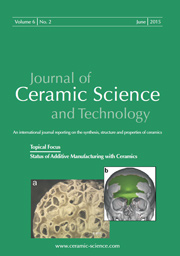Articles
All articles | Recent articles
The Effect of Nano CuO as Sintering Aid on Phase Formation, Microstructure and Properties of Li2O-Stabilized β″-Alumina Ceramics
H. Ahmadi Moghadam, M. Hossein Paydar
Department of Materials Science and Engineering, School of Engineering, Shiraz University, Shiraz, Iran
received September 23, 2016, received in revised form November 11, 2016, accepted November 21, 2016
Vol. 7, No. 4, Pages 441-446 DOI: 10.4416/JCST2016-00075
Abstract
Li2O-stabilized β″-alumina powder was synthesized in the double zeta process with Al2O3, Na2CO3 and Li2CO3 as the starting materials. The effect of nano CuO additive as the sintering aid on phase formation, microstructure, mechanical and electrical properties of Li2O-stabilized β″-alumina ceramics was investigated by means of x-ray diffraction (XRD), scanning electron microscope (SEM), biaxial flexure test (BFT) and ionic conductivity test. The results indicated that the fracture strength of the samples improved with the addition of a low concentration of nano CuO, which can be attributed to the higher density and more uniform microstructure. The optimal amount of nano CuO was determined at about 1.5 mol%, with the addition of which the ionic conductivity was approximately twice as high as that of the sintered samples without any nano CuO.
![]() Download Full Article (PDF)
Download Full Article (PDF)
Keywords
Keywords: β″-alumina ceramics, nano CuO, microstructure, mechanical properties, ionic conductivity
References
1 Sudworth, J.L., Tilley, A.R.: The sodium sulphur battery. Chapman & Hall, London, 1985.
2 Ormrod, S.E., Kirk, D.L.: The conduction properties of polycrystalline β″-alumina, J. Appl. Phys., 10, 1769 – 1780, (1977).
3 Lu, X., Xia, G., Lemmon, J., Yang, Z.: Advanced materials for sodium-beta alumina batteries: status, challenges and perspectives, J. Power. Sources., 195, 2431 – 2442, (2010).
4 Virkar, A.V., Miller, G.R., Gordon, R.S.: Resistivity-microstructure relations in lithia-stabilized polycrystalline β″-alumina, J. Am. Ceram. Soc., 61, 250 – 252, (1978).
5 Oshima, T., Kajita, M., Okuno, A.: Development of sodium-sulfur batteries, Int. J. Appl. Ceram. Technol., 1, 269 – 276, (2004).
6 Chen, K.G., Lin, Z.X., Fan, Z.Z., Xu, X.H., Wen, Z.Y., Yu, B.Q.: Preparation of Na- by partial synthesis method, J. Inorg. Mater., 12, 725 – 728, (1997).
7 Lee, K.M., Lee, S.T., Lee, D.H., Lee, S.M., Lim, S.K.: Phase formation of Na-beta-aluminas synthesized by double zeta process, J. Ind. Eng. Che., 19, 829 – 834, (2013).
8 Nemati, A., Surani, F., Abdizadeh, H., Baharvandi, H.R.: The effects of nano mgo on physical and mechanical properties of Al2O3-SiC composites, J. Ceram. Sci. Tech., 3, 29 – 34, (2012).
9 Zhang, T.S., Kong, L.B., Du, Z.H., Ma, J., Li, S.: Tailoring the microstructure of mechanoactivated Al2O3and SiO2 mixtures with TiO2 addition., J. Alloy. Compd., 506, 777 – 783, (2010).
10 Xu, D., Jiang, H., Li, M., Hai, O., Zhang, Y.: Synthesis and characterization of Y2O3 doped Na- solid electrolyte by double zeta process, Ceram. Int., 41, 5355 – 5361, (2015).
11 Du, G.P., Hu, Z.J., Han, Q.F., Qin, X.M., Shi, W.Z.: Effects of niobium donor doping on the phase structures and magnetic properties of Fe-doped BaTiO3 ceramics, J. Alloy. Compd., 492, L79 – L81, (2010).
12 Yang, L.P., Shan, S.J., Wei, X.L., Liu, X.M., Yang, H., Shen, X.D.: The mechanical and electrical properties of ZrO2-TiO2-Na-β/β″-alumina composite electrolyte synthesized via a citrate sol-gel method, Ceram. Int., 40, 9055 – 9060, (2014).
13 Xu, Y., Fu, R., Yang, Y., Cai, J., Gu, X., Fang, J.: Raman spectra and dielectric properties of Ca0.66Ti0.66La0.34Al0.34O3 microwave ceramics with Nd3+ additions, J. Ceram. Sci. Tech., 7, 257 – 262, (2016).
14 Visco, S.J., Liu, M., Lin, F., Kimes, P., Jonghe, L.C. D.: Properties and morphology of doped polycrystalline Na-β″-alumina electrolytes, Solid State Ionics, 62, 185 – 191, (1993).
15 Boilot, J.P., Thery, J.: Influence of the addition of foreign ions on the relative stability and electrical conductivity of β and β″ alumina type phases, (in French), Mater. Res. Bull., 11, 407 – 413, (1976).
16 Boilot, J.P., Kahn, A., Thery, J., Collongues, R., Antoine, J., Vivien, D., Chevrette, C., Gourier, D.: Influence of foreign ions addition on relative stability and electrical conductivity of β and β″ alumina type phases localization of impurities, Electrochim. Acta., 22, 741 – 745, (1977).
17 Wei, X.L., Cao, Y., Lu, L., Yang, H., Shen, X.D.: Synthesis and characterization of titanium doped sodium beta″-alumina, J .Alloy. Compd., 509, 6222 – 6226, (2011).
18 Hayati, R., Barzegar, A.: Microstructure and electrical properties of lead free potassium sodium niobate piezoceramics with nano ZnO additive, Mater. Sci. Eng. B., 172, 121 – 126, (2010).
19 Saeri, M.R., Barzegar, A., Ahmadi Moghadam, H.: Investigation of nano particle additives on lithium doped KNN lead free piezoelectric ceramics, Ceram. Int., 37, 3083 – 3087, (2011).
20 Sun, Y., Chang. Y., Wu, J., Wang, X., Zhang, S., Wang, R., Yang, B., Cao, W.: Domain structures and piezoelectric properties of low-temperature sintered (Ba0.95Ca0.05)(Ti0.94Sn0.06)O3 ceramics with CuO additive, Mater. Lett., 177, 128 – 131, (2016).
21 Chen, W.S., Tseng, C.F., Lee, Y.M., Tung, H.H., Yang, H.T., Hsu, C.H.: Effect of CuO additives on sintering and dielectric behaviors of CeO2 ceramics, J. Mater. Process. Tech., 209, 2277 – 2281, (2009).
22 Azough, F., Wegrzyn, M., Freer, R., Sharma, S., Hall, D.: Microstructure and piezoelectric properties of CuO added (K, na, Li)NbO3 lead-free piezoelectric ceramics, J. Eur. Ceram. Soc., 31, 569 – 576, (2011).
23 Seoa, T., Choi, J. H,. Nahma, S., Lee, H. G.: Effect of CuO on the sintering temperature and piezoelectric properties of MnO2-doped 0.75Pb(Zr0.47Ti0.53)O3-0.25Pb(Zn1/3Nb2/3)O3 ceramics, J. Alloy. Compd., 509, 3686 – 3689, (2011).
24 Pekarsky, A., Nicholson, P.S.: The relative stability of spray-frozen/freeze-dried powders, Mat. Res. Bull., 15, 1517 – 1524, (1980).
25 Jones, I.W.: Recent advances in the development of sodium-sulphur batteries for load levelling and motive power applications, Electrochim. Acta., 22, 681 – 688, (1977).
26 Gordon, R.S., McEntire, B.J., Miller, M.L., Virkar, A.V.: Processing and characterization of polycrystalline β″– alumina ceramic electrolytes. In: Processing of crystalline ceramics. Palmour, H., Davis, R. F., Hare, T. M., Plenum Press, New York, 1978, pp. 405 – 420.
27 Roth, W.L., Chung, I., Story, H. S.: Characterization of additive-modified beta alumina ceramics by nuclear magnetic resonance, J. Am. Ceram. Soc., 60, 311 – 315, (1977).
28 Dell, R.M., Moseley, T.: Beta-alumina electrolyte for use in sodium/sulfur batteries: part 1. fundamental properties, J. Power. Sources., 6, 143 – 160, (1981).
Copyright
Göller Verlag GmbH


